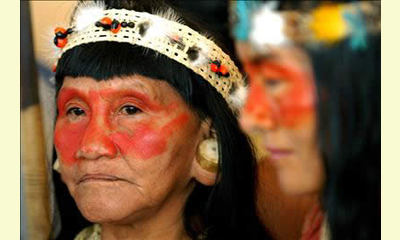|
|
The women of today
un articulo por Gabriela Osorio and Eliana Sánchez
Women and men are part of society and in turn are a key part of
creating a culture of peace. Women should have access to social
participation, as their voice and vote are essential to find
alternative conflict resolution.

click on photo to enlarge
Different countries with indigenous people have begun to involve indigenous women in the important decisions of the community to which they belong, this is a big step towards gender equality and linking ethnic diversity to international reality.
Peru is one of the countries where indigenous women have been excluded historically from politics. However, in 2011 the Ashaninka, Nomatsiguenga andy Awajun women presented in a public meeting to the Peruvian Congress, the "Situation of Indigenous Amazonian Women and proposals for changes to be made in the favor of women" with the objective of presenting demands and proposals about the problem in that region.
The indigenous Amazonian women demand respect for their rights to land as well as attention to their health, education, justice, violence, economic situation and infrastructure. Also they demand adequate enforcement of the national and international norms, in particular those accorded by covenant 169 of the International Labor Organization.
Ivonne Macassi, the coordinator of the Human Rights Program at the Flora Tristán Peruvian Women's Center, who has supported the women of this region, assured that "For the indigenous women, land is essential. It is for land that they struggle for its conservation and its defense." That gives us a clear view of what happens when there is no respect for land rights.
Another serious problem they are protesting is the lack of access to education. Women's illiteracy is 76, 54, 38 and 74 percent in the communities of Nomatsiguenga, Ashaninka, Kakinte and Awajun respectively. In addition, the situation is made worse by the weakness of the State educational system, and the lack of intercultural poltics which are necessary for the development of the indigenous population.
According to specialists, both the State and the Peruvian society should respond to their demands with an intercultural approach (International Union of Food Workers, 2011); these women are not asking anything more than their basic human rights.
It is the responsibility of all of us to encourage the development of women in society as a major player in the participation and to change the macho culture rooted in many Latin American countries so that we can construct a society that is just and free, integrating all members of the society.
Click here for the Spanish version of this article.
|








|
DISCUSSION
Pregunta(s) relacionada(s) al artículo :
Protecting women and girls against violence , Is progress being made?
* * * * *
Comentario más reciente:
:
The 47 CPNN articles devoted to this theme suggest that indeed progress is being made.

|
|









